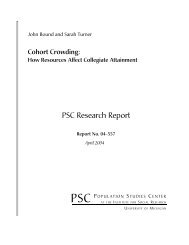Population Ageing and the Well-Being of Older Persons in Thailand ...
Population Ageing and the Well-Being of Older Persons in Thailand ...
Population Ageing and the Well-Being of Older Persons in Thailand ...
Create successful ePaper yourself
Turn your PDF publications into a flip-book with our unique Google optimized e-Paper software.
part a result <strong>of</strong> <strong>the</strong> far higher levels <strong>of</strong> widowhood<br />
among women than men. Among non-married older<br />
persons, most <strong>of</strong> whom are widowed, children or<br />
children-<strong>in</strong>-law are by far <strong>the</strong> most likely to be <strong>the</strong><br />
ma<strong>in</strong> caregiver.<br />
Family support <strong>and</strong> <strong>in</strong>tergenerational<br />
exchanges<br />
The proportion <strong>of</strong> older persons who co-reside with<br />
children has steadily decl<strong>in</strong>ed over <strong>the</strong> last two<br />
decades. Yet even by 2007 over 70 per cent <strong>of</strong><br />
persons age 60 <strong>and</strong> over ei<strong>the</strong>r lived with or next to a<br />
child. The per cent <strong>of</strong> elderly who live alone as well as<br />
<strong>the</strong> per cent who live with a spouse only have both<br />
<strong>in</strong>creased. Still, <strong>in</strong> 2007 only 8 per cent <strong>of</strong> elderly<br />
lived alone <strong>and</strong> <strong>in</strong> half <strong>of</strong> <strong>the</strong>se cases a child lived with<strong>in</strong><br />
<strong>the</strong> same locality. Likewise while one <strong>in</strong> six Thai<br />
elderly lives only with <strong>the</strong>ir spouse, just over half <strong>of</strong><br />
<strong>the</strong>se elderly also have a child resid<strong>in</strong>g <strong>in</strong> <strong>the</strong> same<br />
locality. Also less than 10 per cent <strong>of</strong> elderly who have<br />
children do not have one liv<strong>in</strong>g with<strong>in</strong> <strong>the</strong> same<br />
prov<strong>in</strong>ce.<br />
One type <strong>of</strong> liv<strong>in</strong>g arrangement that has recently<br />
<strong>in</strong>creased is <strong>the</strong> “skip generation” household <strong>in</strong> which<br />
gr<strong>and</strong>parents <strong>and</strong> gr<strong>and</strong>children live toge<strong>the</strong>r<br />
without any middle generation married adults present.<br />
Currently 14 per cent <strong>of</strong> persons aged 60 <strong>and</strong> over<br />
live <strong>in</strong> such households. A considerably higher<br />
proportion have a m<strong>in</strong>or age gr<strong>and</strong>child liv<strong>in</strong>g with<br />
<strong>the</strong>m whose parents live elsewhere or are deceased. In<br />
half <strong>of</strong> <strong>the</strong>se cases <strong>the</strong> gr<strong>and</strong>parents are <strong>the</strong> ma<strong>in</strong><br />
persons responsible for <strong>the</strong>se gr<strong>and</strong>children’s care.<br />
However for more than 80 per cent <strong>of</strong> <strong>the</strong> cases, <strong>the</strong><br />
parents <strong>of</strong> <strong>the</strong> gr<strong>and</strong>children are <strong>the</strong> major f<strong>in</strong>ancial<br />
supporters, presumably through remittances, thus<br />
prevent<strong>in</strong>g gr<strong>and</strong>child care from be<strong>in</strong>g serious<br />
f<strong>in</strong>ancial dra<strong>in</strong> on <strong>the</strong> gr<strong>and</strong>parents.<br />
The trends towards lower co-residence levels <strong>and</strong><br />
higher proportions <strong>of</strong> elderly liv<strong>in</strong>g alone or only with<br />
a spouse are likely to cont<strong>in</strong>ue <strong>in</strong> <strong>the</strong> future. A ma<strong>in</strong><br />
contribut<strong>in</strong>g factor will be <strong>the</strong> smaller family sizes that<br />
will characterize <strong>the</strong> future generations <strong>of</strong> older<br />
persons. So far <strong>the</strong>se changes <strong>in</strong> liv<strong>in</strong>g arrangements<br />
have not been accompanied by a decl<strong>in</strong>e <strong>in</strong> filial<br />
material support as already noted. In addition, <strong>the</strong><br />
widespread <strong>in</strong>crease <strong>in</strong> access to telephones,<br />
particularly <strong>in</strong>expensive cell phones, has provided a<br />
new <strong>and</strong> effective way for elderly parents <strong>and</strong> <strong>the</strong>ir<br />
migrant children to ma<strong>in</strong>ta<strong>in</strong> social contact. Over a<br />
third <strong>of</strong> older persons with non co-resident children<br />
have daily or weekly telephone contact with <strong>the</strong>m <strong>and</strong><br />
almost two-thirds report at least monthly contact.<br />
Despite frequent highlight<strong>in</strong>g <strong>of</strong> examples <strong>of</strong> elderly<br />
parents deserted by <strong>the</strong>ir adult children <strong>in</strong> <strong>the</strong> mass<br />
media, such cases are relatively uncommon on a<br />
population basis. Only a little more than one per cent<br />
<strong>of</strong> elderly parents report no contact with any <strong>of</strong> <strong>the</strong>ir<br />
children dur<strong>in</strong>g <strong>the</strong> prior year <strong>and</strong> even less had<br />
nei<strong>the</strong>r contact nor received remittances from any<br />
child. Even among <strong>the</strong> m<strong>in</strong>ority <strong>of</strong> parents whose<br />
children all live away from <strong>the</strong> parental prov<strong>in</strong>ce,<br />
under 3 per cent receive no monetary support or<br />
contact from any child. Thus so far <strong>in</strong>tergenerational<br />
solidarity between older age parents <strong>and</strong> <strong>the</strong>ir adult<br />
children appears relatively <strong>in</strong> tact <strong>in</strong> Thail<strong>and</strong>.<br />
Policy <strong>and</strong> programme responses<br />
Before <strong>the</strong> early 1990s, <strong>the</strong> Thai government’s response<br />
to population age<strong>in</strong>g was relatively slow <strong>and</strong> passive<br />
but s<strong>in</strong>ce <strong>the</strong>n <strong>the</strong>y are far more active <strong>and</strong><br />
progressive. Recent responses <strong>in</strong>clude <strong>the</strong> formulation<br />
<strong>of</strong> a new national plan on age<strong>in</strong>g, enactment <strong>of</strong> laws<br />
<strong>and</strong> regulations concern<strong>in</strong>g elderly well-be<strong>in</strong>g, <strong>and</strong> <strong>the</strong><br />
establishment <strong>of</strong> organizations to encourage<br />
consideration <strong>of</strong> elderly related issues <strong>in</strong> government<br />
programmes. The private sector response has ma<strong>in</strong>ly<br />
been <strong>the</strong> establishment <strong>of</strong> for pr<strong>of</strong>it nurs<strong>in</strong>g homes<br />
although systematic <strong>in</strong>formation is largely lack<strong>in</strong>g.<br />
Until relatively recently, government guaranteed<br />
retirement benefits were limited to government <strong>and</strong><br />
state enterprise employees. In 1991, a national social<br />
security system was launched to cover <strong>the</strong> private<br />
sector but not until 1999 did it <strong>in</strong>clude provisions for<br />
old age pensions <strong>and</strong> <strong>the</strong>se require 15 years <strong>of</strong><br />
xi















